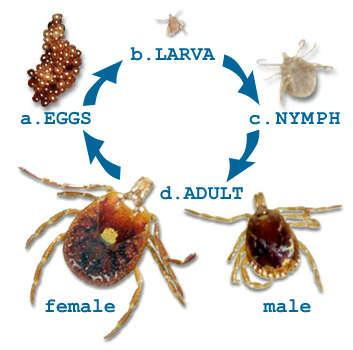
My pet had a tick? Is he going to get sick?
In Oklahoma we can see ticks year-round. Ticks are among the most efficient carriers of disease. Ticks attach firmly and begin sucking blood. They feed slowly and may easily be overlooked. Tick bites can also become infected. This means your pet may need to be on some type of tick prevention, even in the winter months. We offer various types of tick prevention that are effective such as: collars, topicals, and oral medications. There are different products that may be a better combination for your pet. One of our veterinarians or technicians would be happy to discuss the best product for your dog or cat.
Female ticks deposit their eggs on the ground, one female can lay 3,000-6,000 eggs. The tiny larva that hatch are called seed ticks. They then develop into a larger nymph and then an adult. All distinct life stages need to feed on a host.
If your pet has a tick you can use a blunt tweezers and grasp the tick as close as possible to the skin surface. Pull the tick straight out with a steady, even pressure. It is important to not twist or jerk the tick as this may cause the mouthparts to break off and remain in the skin. Continue applying steady pressure as it may take a minute or two for the tick to release.
Not all ticks will transmit tick disease to your pet. We do see many tick diseases in Oklahoma.
The most common tick diseases we see in Oklahoma are listed below:
- Ehrlichia: Signs of ehrlichia usually develop within 8-20 days. The early phase of this disease may last 4-6 weeks with dogs having fever, depression, bruising, enlarged lymph nodes, discharge from eyes and nose, and respiratory problems. Some dogs may be infected and not show any clinical signs for months to years. Stress can then cause these dogs to develop severe clinical signs. Dogs can also become chronically infected and exhibit mild symptoms that can affect various organs
- Rocky Mountain Spotted Fever: Signs of disease may develop as soon as 2-3 days after exposure to an infected tick. Fever and depression are the most common signs seen. Some dogs also develop bruising, nose bleeds, enlarged lymph nodes, and swelling of the limbs. Once a dog has recovered they should not become chronically infected with this disease.
- Anaplasmosis: This is a newer tick disease but can be found in Oklahoma. This tick disease causes lameness and bruising. Dogs and cats infected with this bacteria can also become subclinically infected or have a chronic carrier state.
- Lyme: The tick that carries Lyme disease is not currently in OK but there are some studies that are suggesting that this tick may eventually migrate to OK. Lyme disease causes fever, enlarged lymph nodes, arthritis, and joint pain. Some dogs may even exhibit neurologic signs such as seizures or behavior changes.
- Cytauxzoon: This disease is often called bobcat fever. Cats are infected with this protozoa after being bit by an infected tick. Cats generally will remove ticks from themselves so owners may not have seen a tick on the infected cat. The most common clinical signs are high fever, anorexia, depression, jaundice, and labored breathing. This disease process is rapid and commonly fatal.
If you have any concerns that your pet is showing any of these signs described above, please contact our office.
